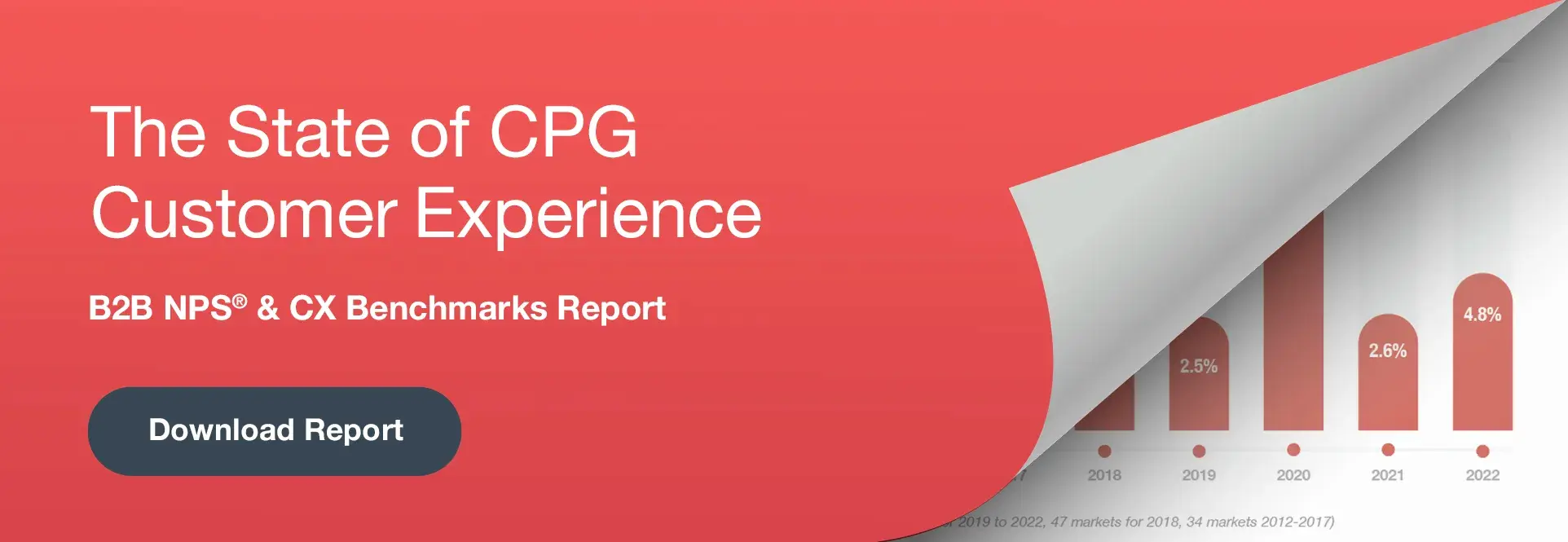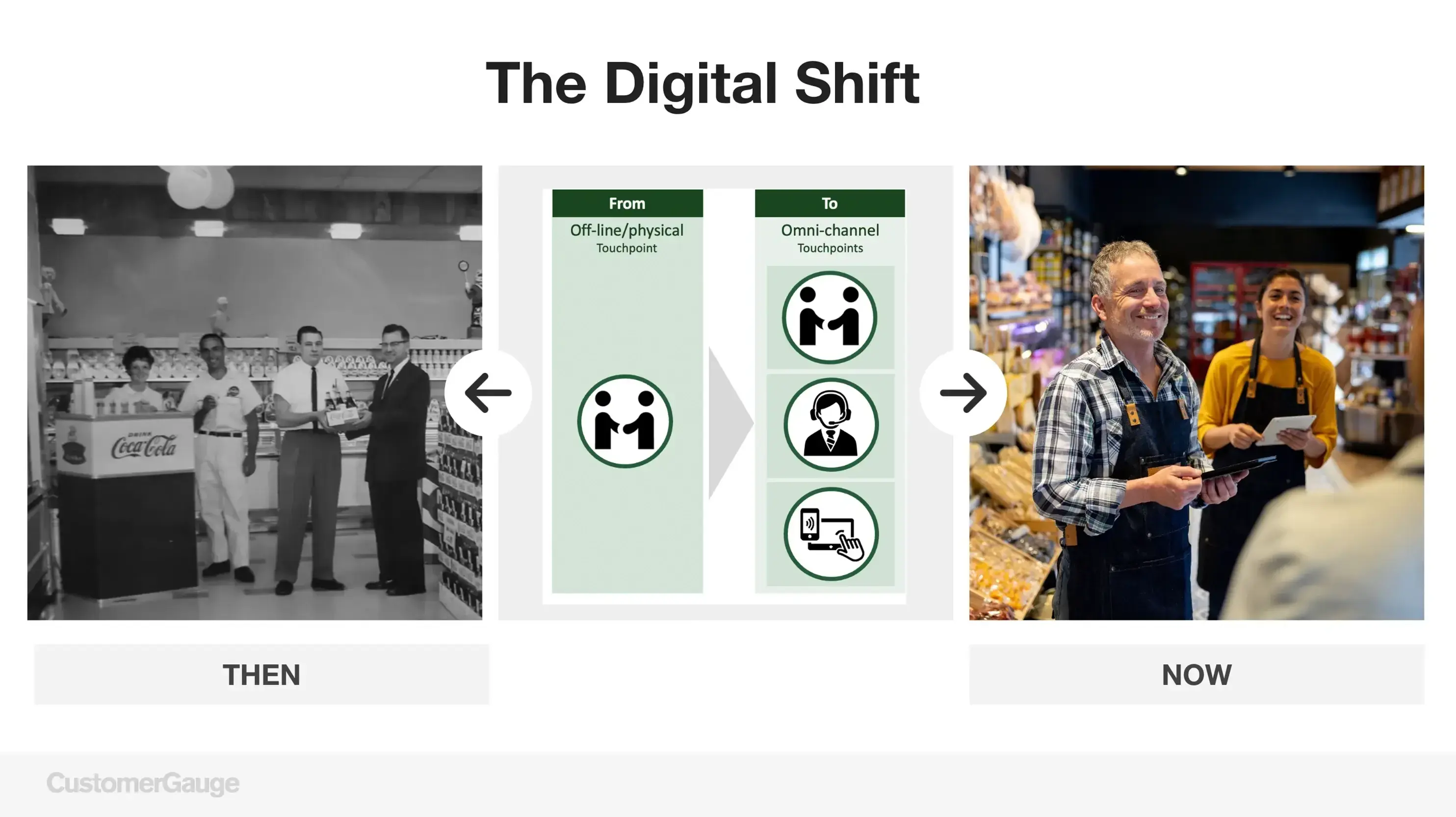In a market as competitive as Consumer Packaged Goods (CPG), businesses are no longer looking for ways to keep up. Companies want to understand what's next to get ahead of the competition and which areas to invest in.
Enter: digital transformation.
We learned at The CPG Digital Transformation Summit that every field is digitalizing whether businesses are ready for it or not.
During The Summit, Vitaliy Novikov, Group Digital Commerce Director at Coca-Cola HBC stated, “Digital transformation is bringing us closer to consumers — it's called CPG for a reason.”
For Vitaliy, technology is opening new doors to businesses enabling them to provide better, faster, and more innovative service for customers and consumers.
Failing to adapt and embrace digital strategies will be a massive strategic disadvantage moving forward for CPG. Not to mention other risks — we’ll get to those later.
Let’s start by breaking down digital transformation and how it’s affecting CPG.

What Is Digital Transformation?
Digital transformation refers to the process of integrating digital technologies into various aspects of an organization's operations, processes, products, and services to fundamentally change how they operate and deliver value to its customers.
It involves using digital technologies to streamline operations, improve efficiency, enhance customer experiences, and create new business models.
Digital transformation typically involves adopting technologies such as cloud computing, data analytics, artificial intelligence (AI), Internet of Things (IoT), and automation.
It also involves rethinking existing processes to leverage the capabilities offered by emerging technologies.
In today’s CPG customer experience, this translates to the ‘Digital Shift.’

The digital shift has transitioned from businesses only having in-person touchpoints to an omni-channel strategy encompassing all customer channels.
B2B omni-channel touchpoints allow frontline teams to meet with customers where they are; this can still include in-person, but can also be over the phone and online.
Here are a few of the key aspects of digital transformation:
CX enhancement. Leveraging digital channels to engage with customers more effectively, provide personalized experiences, and deliver seamless interactions across the entire customer journey — covering every critical touchpoint in the B2B customer journey is key to driving a strong digital transformation strategy, more on that in a minute.
Operational efficiency. Using digital technologies to automate processes, optimize operations, and improve organizational productivity.
Data-driven decision making. Harnessing data analytics and insights to make informed decisions, identify opportunities, and predict future trends.
Forward-thinking innovation. Encouraging a culture of innovation by experimenting with new technologies, processes, and business models to stay competitive in the rapidly evolving digital landscape.
Agility and adaptability. Quickly adapting to market conditions, customer preferences, and technological advancements by leveraging digital tools and strategies.
Aside from making business operations quicker than ever, digital transformation is not just about adopting new technologies but fundamentally reshaping the way organizations operate, collaborate, and create value in the digital age.
So, how can not going digital make a big impact on business? Let’s find out.
How Not Going Digital Can Negatively Impact Business
You can choose not to adapt to digital transformation trends within CPG, but it’ll cost you. Let’s look at four key areas that will take a hit if they aren’t modernized.
Poor Customer Experience and B2B Relationships
How can your frontline build meaningful relationships with customers if you’re not meeting them where they are in the customer journey?
Right now, the most successful CPG companies collect feedback from the head office to outlets in an “always-on” fashion to anticipate customer needs.
This helps businesses create an action plan for better service and growth targeting customers who represent the biggest problems and opportunities.
Stuart Ward, Head of Sales Capability at Coca-Cola HBC recently shared on our CPG Experience Roundtable how his team transitioned from their inefficient CX operations to leveraging CustomerGauge’s platform as far back as mid-pandemic in 2020:
Customers increasingly expect seamless digital experiences, such as easy online ordering, quick support through digital channels, and personalized interactions.
By not listening to customers regularly and acting quickly on their feedback, customers will feel they’re not being heard, increasing the likelihood of churn.
Additionally, without an operational management tool that tracks every critical touchpoint in the customer journey, brands won’t hear from happy customers, too, missing out on valuable upsell and cross-sell opportunities.
To continue growing marketshare, CPG companies cannot neglect their digital presence.

Inefficient Operations
Imagine running a business where every task, from processing orders to tracking inventory, relies on manual paperwork and spreadsheets.
Without digital tools to streamline operations, there isn’t a clear window to view what's happening across an organization. Plus, each department might be using its own outdated system, resulting in fragmented data and limited collaboration — silos are so last year.
And when it comes to responding to customer needs, the lack of agility can be frustrating for everyone involved. Orders take longer to fulfill, inquiries get lost in the shuffle, and customers are left waiting.
By embracing digital tools and technologies, organizations can streamline their processes, automate repetitive tasks, and optimize resource allocation, leading to significant improvements in efficiency and productivity.
Decreased Sales and Revenue
The digital transformation of procurement processes is reshaping the landscape for B2B purchasing for CPG.
As more businesses move towards online platforms like eB2B marketplaces, suppliers who lack a robust digital presence risk losing out on valuable business opportunities.
CPG companies that fail to establish themselves effectively in the online marketplace may find themselves overlooked by B2B buyers in favor of competitors with a stronger digital footprint.
Without a well-defined digital strategy, brands will miss out on crucial contracts.
Lack of Competitive Edge
In today's hyper-competitive market landscape, staying ahead of the curve is essential for survival.
CPG companies that neglect digital transformation risk falling behind competitors who are actively investing in technology and innovation — remember Stuart Ward earlier? Coca-Cola HBC has been far ahead of the game, digitizing business efforts over the last four years.
Whether it's adopting AI-driven supply chain solutions, implementing IoT devices for inventory management, or launching targeted digital marketing campaigns, companies that embrace digitalization gain a competitive edge by enhancing efficiency, agility, and customer satisfaction.
Where Are Companies Going Wrong With Digital Transformation?
Digitalizing business operations can seem daunting for some, while exciting for others.
And no matter what bucket your company might fall into, we’re finding that organizations are making a few mistakes in the process.
The #1 mistake we’re seeing CPG companies make while taking on B2B digital transformation strategies is not doing the technical work first.
Vitaliy Novikov, Group Digital Commerce Director for Coca-Cola HBC recently spoke at The CPG Digital Transformation Summit and shared,
“You need to do all the work that is partly boring and very technical before you can really say, ‘Ok, now I’m clear and I can go after two or three opportunities that are scaled.
To identify your business needs, understand what your business model can solve, and use technology that exists, not breakthrough but already proven is what you should be going after.”
The secret is not falling in love with technology just yet and putting in the work first to clarify the next steps.
Other oversights CPG brands are having with digital transformation include:
Lack of a customer touchpoint strategy. Remember what I shared earlier? The CPG companies that aren’t monitoring every touchpoint in their B2B customer journey are simply not meeting their needs anymore. To succeed in 2024 and beyond, brands must meet their customers at the most critical touchpoints and listen to their feedback in real-time.
Not addressing unmet business needs first. One of many business pitfalls our CPG experience experts have seen is positioning a digital solution first instead of reverse engineering it. CPG has been jumping the gun looking for the right place to launch a new gadget rather than understanding potential business opportunities and which solution customers need and why.
Unorganized data. What is your data strategy? What type of data sources are you working with? What tools will you work with and how will you integrate them? It’s all about connecting silos of customer data and pulling meaningful insights from it to inform decisions on your digital solutions.
At The Digital Transformation Summit, CustomerGauge VP of CPG CX Frederik van Os, went into detail on additional areas where companies have been going wrong over the last several years.
Frederik continued breaking down the disruption to the route to market and how it’s one of the main areas that are at risk of being altered through digitalization.
This is due to customer needs evolving. With quick and easy ordering solutions (for example, Amazon) on their smartphones, businesses will need to keep up with these new players.
What Does a Good Digital Transformation Strategy Look Like?
To shape successful CPG B2B customer experiences, brands must track every critical touchpoint along the customer journey. Every interaction contributes to the overall value proposition, from sales and trade intermediaries to diverse retail outlets.
That’s why a good digital transformation strategy requires meticulous organization and integration of data flows, ensuring a seamless, automated process.
In CPG, the journey to the end consumer predominantly runs through B2B networks, each comprising its own ecosystem of diverse actors.
The challenge is not only optimizing internal operations but also aligning with the intricate dynamics of these B2B networks.
As Vitaliy shares below,
“A good digital transformation strategy will take into account all these interaction points and benefit from collecting data from these points and then making sense of it, ideally in an automated integrated, constantly flowing way.”
Scale Business With the Modern Way of Collecting B2B Channel Feedback in CPG
From missed opportunities for consumer engagement and limited market reach to decreased sales and revenue, the consequences of ignoring digital transformation are significant.
It’s not only about remaining competitive but finding innovative opportunities to boost your bottom line!
CPG companies must prioritize digitalization, invest in technology, and adapt their strategies to meet the evolving needs of consumers — those that already are, are way ahead of you.
Embracing digital transformation isn't just a choice; it's a necessity for long-term success in the modern business landscape.

